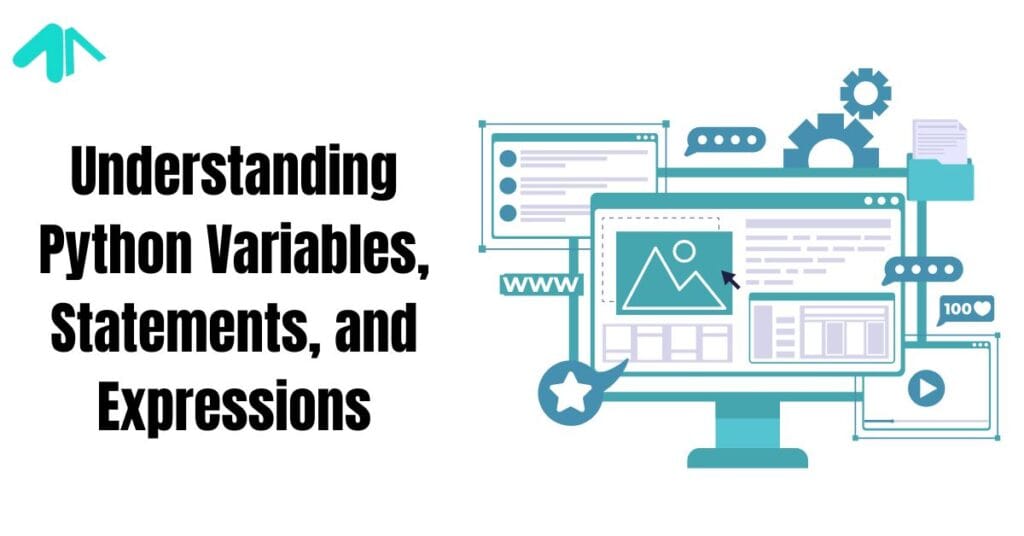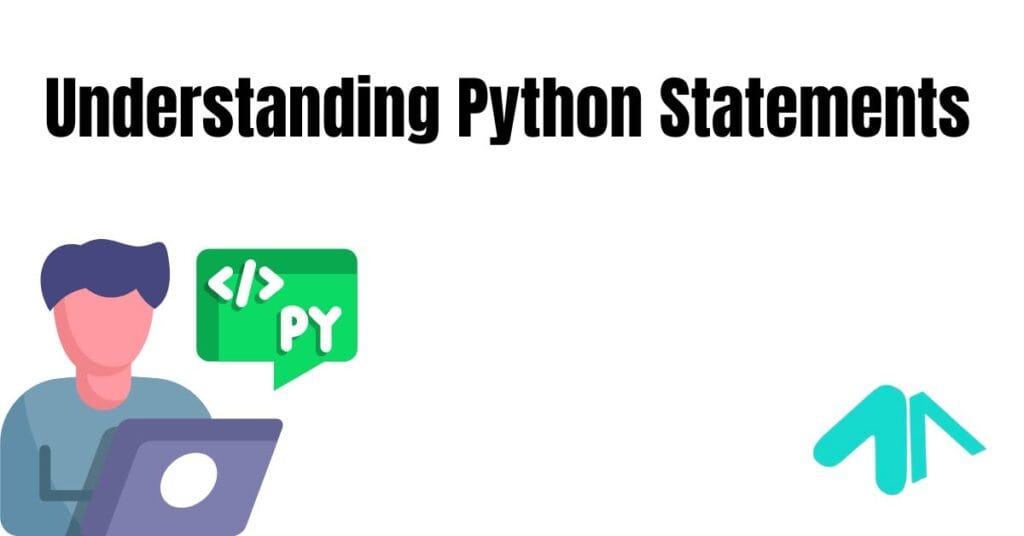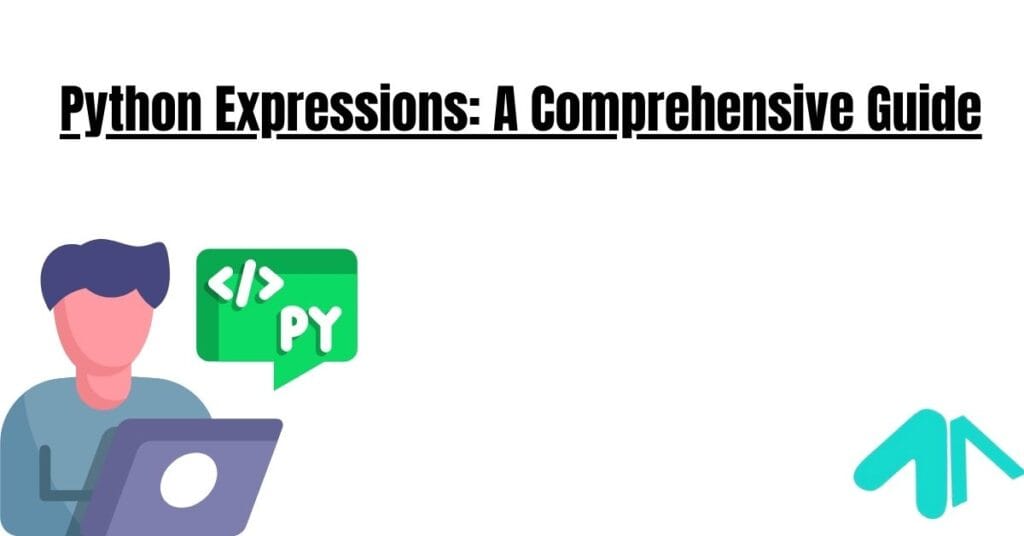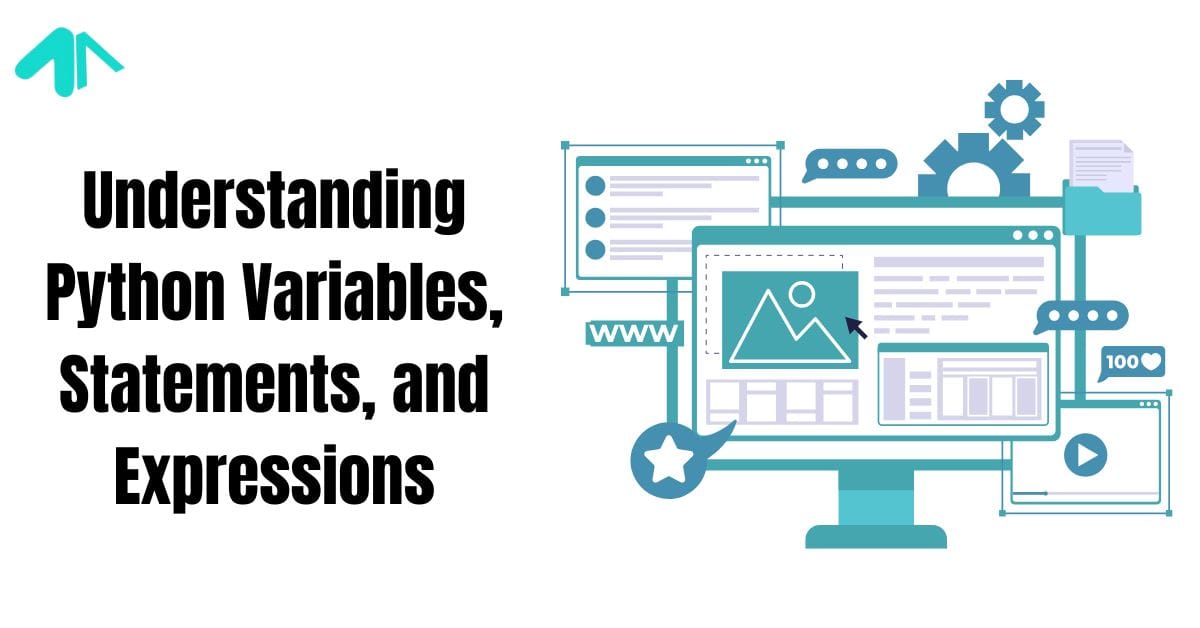2025 Python Variables Statements and Expressions
In Python, variables, statements, and expressions are the core elements that form any program. Variables are used to store data, which can be modified and reused later.

Statements are instructions that the Python interpreter can execute, such as assigning a value to a variable or printing output. Expressions, on the other hand, are combinations of values and operators that produce a new value. Together, these three components allow developers to create dynamic and interactive programs in Python.
Understanding Python Variables: A Beginner’s Guide
Introduction
Python is an easy-to-learn programming language. One of the key concepts in Python is variables. Variables store data that can change while a program runs.

What is a Variable in Python?
A variable is a name given to a value stored in memory. Think of it like a label for a piece of data.
Example:
x = 10 # x holds the value 10
y = "Hello, Python!" # y holds a string
Rules for Naming Variables
- Must start with a letter (A-Z or a-z) or an underscore
_. - Can contain letters, digits (0-9), or underscores
_. - Case-sensitive (
ageandAgeare different). - Cannot use Python keywords (
if,for,while, etc.).
Valid and Invalid Examples:
valid_name = "Python" # Valid
_name = 50 # Valid
name123 = 100 # Valid
1name = 10 # Invalid (starts with a number)
if = 20 # Invalid (uses a keyword)
my-variable = 30 # Invalid (hyphens not allowed)
Assigning Values to Variables
1. Single Assignment:
name = "John"
age = 25
height = 5.9
2. Multiple Assignments in One Line:
x, y, z = 10, 20, 30
3. Assigning the Same Value to Multiple Variables:
a = b = c = 100
Types of Variables in Python
Python automatically assigns types based on values.
| Data Type | Example |
|---|---|
Integer (int) | num = 10 |
Float (float) | pi = 3.14 |
String (str) | text = "Hello" |
Boolean (bool) | is_valid = True |
List (list) | numbers = [1, 2, 3] |
Tuple (tuple) | coordinates = (10, 20) |
Dictionary (dict) | person = {"name": "John", "age": 25} |
Checking a Variable’s Type
x = 10
print(type(x)) # Output: <class 'int'>
Variable Scope in Python
1. Local Variables (inside a function, accessible only there)
def my_function():
local_var = "I am local"
print(local_var)
my_function()
2. Global Variables (declared outside functions, accessible anywhere)
global_var = "I am global"
def my_function():
print(global_var)
my_function()
print(global_var)
3. Using global Keyword (modifying a global variable inside a function)
global_var = 10
def change_global():
global global_var
global_var = 20
change_global()
print(global_var) # Output: 20
Best Practices for Using Variables
- Use meaningful names (
student_nameinstead ofs). - Follow Python conventions (
snake_caselikeuser_age). - Use uppercase for constants (
PI = 3.14).
Real-World Example: Calculating Area of a Rectangle
width = 5
height = 10
area = width * height
print("The area of the rectangle is:", area)
Output:
The area of the rectangle is: 50
FAQs
1. What is the difference between = and ==?
= assigns a value (x = 10).== checks equality (x == 10).
2. Can a variable name start with a number?
No, it must start with a letter or _.
3. How do I delete a variable?
del x # Deletes variable x
4. Can I change a variable’s type?
Yes, Python allows dynamic typing.x = 10 x = "Now I am a string"
Python Expressions: A Comprehensive Guide
Expressions are a fundamental part of Python programming, allowing us to perform calculations, manipulate data, and create logical conditions.

What is an Expression in Python?
An expression in Python is a combination of values, variables, operators, and function calls that produce a result. It is evaluated by Python and returns a value. Expressions are widely used in assignments, conditions, loops, and function calls.
Example:
x = 5 + 3 # Here, '5 + 3' is an expression that evaluates to 8
print(x) # Output: 8
Expressions play a crucial role in making programs dynamic and interactive. They can be as simple as arithmetic calculations or as complex as function calls and conditional statements.
Types of Expressions in Python
Python supports different types of expressions based on their purpose and the type of values they return.
1. Arithmetic Expressions
Arithmetic expressions perform mathematical operations using operators like +, -, *, /, //, %, and **.
Example:
a = 10
b = 5
sum_result = a + b # Addition
product_result = a * b # Multiplication
div_result = a / b # Division
print(sum_result, product_result, div_result)
2. Relational (Comparison) Expressions
Relational expressions compare values using comparison operators such as ==, !=, <, >, <=, and >=. These expressions return Boolean values (True or False).
Example:
x = 10
y = 20
print(x > y) # False
print(x == 10) # True
3. Logical Expressions
Logical expressions use logical operators (and, or, not) to evaluate multiple conditions and return a Boolean value.
Example:
is_sunny = True
is_warm = False
print(is_sunny and is_warm) # False
print(is_sunny or is_warm) # True
4. Bitwise Expressions
Bitwise expressions manipulate individual bits using operators like &, |, ^, ~, <<, and >>.
Example:
a = 5 # Binary: 0101
b = 3 # Binary: 0011
print(a & b) # Output: 1 (Bitwise AND)
print(a | b) # Output: 7 (Bitwise OR)
5. Identity Expressions
Identity expressions check if two variables reference the same object using is and is not.
Example:
x = [1, 2, 3]
y = x
z = [1, 2, 3]
print(x is y) # True
print(x is z) # False (different objects with same content)
6. Membership Expressions
Membership expressions check whether a value is present in a sequence (list, tuple, string) using in and not in.
Example:
fruits = ["apple", "banana", "cherry"]
print("banana" in fruits) # True
print("grape" not in fruits) # True
7. Lambda Expressions
Lambda expressions (or anonymous functions) are single-expression functions that return a value.
Example:
square = lambda x: x * x
print(square(5)) # Output: 25Evaluating Expressions in Python
Python evaluates expressions based on operator precedence and associativity. It follows the BODMAS rule (Brackets, Orders, Division, Multiplication, Addition, Subtraction).
Precedence of Operators
Operators with higher precedence are evaluated first. Here is the order of precedence from highest to lowest:
- Parentheses
() - Exponentiation
** - Multiplication
*, Division/, Floor Division//, Modulus% - Addition
+, Subtraction- - Comparison Operators (
==,!=,>,<,>=,<=) - Logical Operators (
not,and,or)
Example:
result = 10 + 5 * 2 # Multiplication (*) is performed first
print(result) # Output: 20
To change the evaluation order, use parentheses:
result = (10 + 5) * 2
print(result) # Output: 30Real-World Applications of Expressions
Expressions are widely used in programming. Here are some practical applications:
- Mathematical Calculations:
radius = 7 area = 3.14 * radius ** 2 # Circle area formula print("Area:", area) - Conditional Logic:
age = 18 if age >= 18: print("Eligible to vote") else: print("Not eligible") - String Manipulation:
name = "Python" print(name.upper()) # Converts to uppercase - Data Filtering:
numbers = [10, 15, 22, 30, 35] even_numbers = [num for num in numbers if num % 2 == 0] print(even_numbers) # Output: [10, 22, 30]
FAQs
1. What is an expression in Python?
An expression is a combination of values, variables, and operators that produces a result when evaluated.
2. What is the difference between an expression and a statement?
An expression returns a value, whereas a statement performs an action (e.g., assignment, loops, function definitions).
3. How do logical expressions work?
Logical expressions use and, or, and not to evaluate multiple conditions and return Boolean values.
4. What is a lambda expression in Python?
A lambda expression is an anonymous function that takes arguments and returns a single expression.
5. How does Python evaluate expressions?
Python evaluates expressions based on operator precedence, following the BODMAS rule.
Understanding Python Statements
Python is a popular and easy-to-learn programming language known for its clean and readable syntax. One of the most important parts of any programming language is its statements.

Python statements are the building blocks of any Python program. They are instructions that tell the Python interpreter what to do.
What Are Python Statements?
A statement in Python is a command that the interpreter can execute. When you write Python code, you are essentially giving the computer a set of instructions to follow. Each line of code in Python is typically a statement.
For example:
print("Hello, World!")
In this example, print("Hello, World!") is a statement. It tells Python to print the text “Hello, World!” to the screen.
Types of Python Statements
Python has different types of statements, and each type serves a specific purpose. Here are the main categories:
- Simple Statements
- Compound Statements
- Expression Statements
- Assignment Statements
- Control Flow Statements
- Looping Statements
- Function and Class Statements
Let us explore each of these in detail.
1. Simple Statements
A simple statement is a single line of code that performs a specific action. These statements do not contain other statements inside them.
Examples of simple statements:
x = 10 # Assignment statement
print(x) # Print statement
In these examples, both lines are simple statements.
2. Compound Statements
A compound statement is a group of multiple statements. These statements often include other statements inside them and usually use indentation to define their scope.
Examples of compound statements:
if x > 5:
print("x is greater than 5")
Here, the if statement is a compound statement because it contains another statement (print() function) inside it.
3. Expression Statements
An expression statement is a type of statement that evaluates an expression. It computes a value but does not store it unless assigned to a variable.
Example:
5 + 3
This calculates 5 + 3 but does nothing with the result.
4. Assignment Statements
Assignment statements are used to assign a value to a variable.
Example:
x = 20
Here, the value 20 is assigned to the variable x.
Multiple Assignments
Python allows you to assign multiple variables at once.
Example:
a, b, c = 5, 10, 15
print(a, b, c)
5. Control Flow Statements
Control flow statements manage the flow of execution in a Python program. These include:
ifStatementif-elseStatementif-elif-elseStatement
Example:
x = 10
if x > 5:
print("x is greater than 5")
else:
print("x is not greater than 5")
6. Looping Statements
Looping statements repeat a block of code multiple times. Python supports two main types of loops:
For Loop
for i in range(5):
print(i)
This prints numbers from 0 to 4.
While Loop
count = 0
while count < 5:
print(count)
count += 1
This prints numbers from 0 to 4 using a while loop.
7. Function and Class Statements
Functions and classes help organize code and reuse logic.
Function Definition
def greet():
print("Hello!")
greet()
Class Definition
class Animal:
def speak(self):
print("Animal speaks")
cat = Animal()
cat.speak()
Special Statements in Python
Pass Statement
The pass statement does nothing and is used as a placeholder.
Example:
if True:
pass
Break Statement
The break statement stops a loop immediately.
Example:
for i in range(10):
if i == 5:
break
print(i)
Continue Statement
The continue statement skips the current loop iteration.
Example:
for i in range(5):
if i == 2:
continue
print(i)
Return Statement
The return statement sends a value back from a function.
Example:
def add(a, b):
return a + b
result = add(3, 4)
print(result)
Multi-Line Statements
Python usually treats each line as a new statement, but you can extend a statement across multiple lines using:
- Backslash
\
total = 1 + 2 + 3 + \
4 + 5
- Parentheses
(), Brackets[], or Braces{}
numbers = [1, 2, 3,
4, 5, 6]
FAQs
1. What is a statement in Python?
A statement in Python is a line of code that the interpreter can execute, such as print statements or loops.
2. What is the difference between a simple and compound statement?
A simple statement is a single instruction, while a compound statement contains other statements within it.
3. How do you write multi-line statements in Python?
Use a backslash \ or parentheses () to extend a statement across multiple lines.
2025 Python Variables Statements and Expressions Summary
Python variables, statements, and expressions form the foundation of any Python program. Variables store data, statements give instructions, and expressions evaluate values. Python supports different types of statements like simple, compound, control flow, and looping statements. Understanding these concepts is essential for writing efficient and organized Python code.

